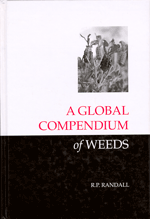 |
A global compendium of weedsBy R.P. (Rod) Randall
Published in 2002 by RG and FJ Richardson, hard cover, 906 pages
Special Price (while stocks last) $A20.00, plus $A13.50 postage within Australia [up to 3 kg], overseas postage please request a quote
ISBN 0 9587439 83 or ISBN 9780958743983 |
Predicting which plants will become weeds is difficult, with the single most important indicator of a species' weed potential, over all other attributes, being a documented weedy history.
Until now, the most comprehensive coverage of the world's weed flora was produced in 1979 by Holm et al. (A Geographic Atlas of World Weeds) and listed 6400 species. In this compendium, Rod Randall has compiled a list of almost 21,000 entries comprising over 18,000 weedy taxa and 2500 alternate name records - it represents a huge increase in the number of documented weed species globally. The information presented is specifically designed to give a weed risk assessor, or anyone interested in the weed potential of a plant, a condensed report of the status of a species with, most importantly, further avenues for finding more information through the extensive reference listing.
The compendium commences with an introduction on how best to use it, and ends with a comprehensive index containing more than 15,000 alternate scientific names and 27,000 common names in numerous languages.
A sample page is available as a PDF file.
Each record consists of:
Genus, Species, Author
Family
Alternate names
Common names: including French, German, Finnish, Italian, Japanese (phonetic), Portuguese and Spanish
Status: Weed, Sleeper, Quarantine Weed, Noxious Weed, Naturalised, Native Weed, Introduced, Garden Escape, Environmental Weed, Cultivation Escape and Casual Alien
Source Codes: References cited
Life Form
Arid/Aqua - a basic measure of a plant's ability to survive
Cultivated or Promoted
Herbal
Toxic
Origin
While people continue to move plants around the world with little regard for the consequences of their actions, new weeds will continue to appear.
The production of this book has been supported by the CRC for Australian Weed Management, Department of Agriculture Western Australia, United States Geological Survey, Missouri Botanic Garden Press and North Carolina Botanical Garden of the University of North Carolina at Chapel Hill.